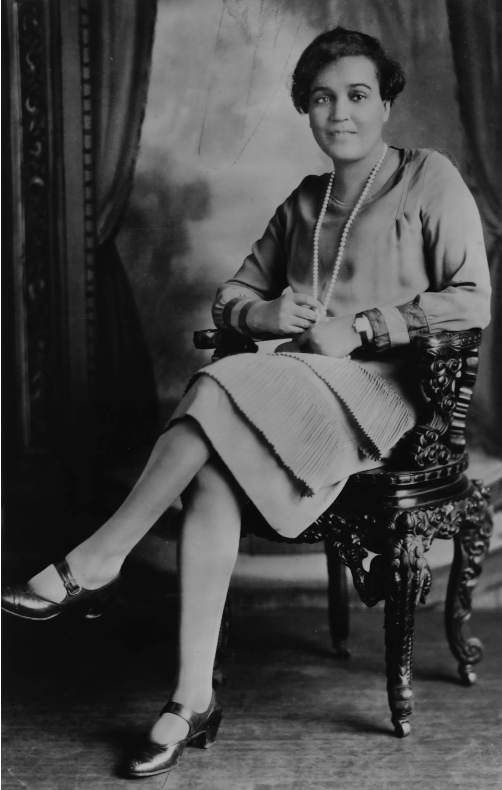Jessie Redmon Fauset: The Unsung Heroine of the Harlem Renaissance
The NAACP (National Association for the Advancement of Colored People) was housed in our neighborhoods for decades, first in the 12-story Beaux Arts style office building at 70 Fifth Avenue that was constructed in 1912 by architect Charles Alonzo Rich for the noted publisher and philanthropist George A. Plimpton. Shortly after the building opened, the NAACP, as well as The Crisis, the literary arm of the NAACP that was co-founded and edited by W. E. B. Du Bois, and the very first magazine dedicated to African Americans, called this their home. This was a time of extraordinary growth, accomplishment, and challenges for what would become our nation’s oldest and largest civil rights organization. And at the heart of the artistic flourishing of the organization was Jessie Redmon Fauset, the journal’s first literary editor.

Jessie Redmon Fauset was born on April 27, 1882 in Camden County, New Jersey. She was the 7th child born into the family. At a very early age, Fauset lost her mother and was raised by her father, a prosperous Presbyterian minister. Fauset’s father made sure his daughter had a well-rounded childhood and an excellent education.

In 1900, Fauset graduated with honors from the renowned Philadelphia (Pennsylvania) High School for Girls and was the only African American in her graduating class. Following her graduation, Fauset received a scholarship to attend Cornell University, and in 1905 made history again by becoming the first black woman accepted into the university chapter of Phi Beta Kappa, a prestigious academic honor society. Fauset graduated with a Bachelor of Arts in classical languages from Cornell University in 1909. Twenty years later she received a Master of Arts in French from the University of Pennsylvania.

In 1912, Fauset began to write for The Crisis. After several years of contributing poems, essays, and reviews, W.E.B. Dubois hired Fauset to become the journal’s literary editor in 1919, and she moved to New York City for the position.
In her role as literary editor, Fauset introduced then-unknown writers, including Countee Cullen, Langston Hughes, and Anne Spencer, among others, to a national audience. In his memoir The Big Sea, Langston Hughes writes, “Jessie Fauset at The Crisis, Charles Johnson at Opportunity, and Alain Locke in Washington were the three people who midwifed the so-called New Negro literature into being. Kind and critical—but not too critical for the young—they nursed us along until our books were born.” Faucet aided the careers of many of the most notable writers from the Harlem Renaissance, publishing Hughes’s first poem, “The Negro Speaks of Rivers,” in 1921, and Gwendolyn Bennett’s début poem, “Nocturne,” in 1923.
Along with her poetry and short fiction in The Crisis, Fauset published four novels (the most of any writer during the Harlem Renaissance) known for their portrayal of middle-class African American life, including There Is Confusion (1924) and Plum Bun (1928), The Chinaberry Tree (1931), and Comedy: American Style (1933). Although Fauset brought the work of younger artists to the public’s attention during the Harlem Renaissance, she holds the distinction of being the most published novelist of that era.

In keeping with her desire to teach black children pride in their heritage and to encourage their creativity, she cofounded and edited a monthly children’s magazine, the Brownies’ Book (1920–1921). This magazine featured historical biographies of notable black people such as Denmark Vesey and Sojourner Truth, articles about Africa, current events, games, riddles, and music.

Jessie Fauset left The Crisis in 1926 and returned to the classroom. She taught at DeWitt Clinton High School in the Bronx until her retirement in 1944. Fauset married Hubert Harris, an insurance broker, in 1929 when she was 47. They remained married until his death in 1958. Fauset then returned to Philadelphia, where she lived until her death on April 30, 1961.
According to Cheryl A. Wall, the author of Women of the Harlem Renaissance, “The Harlem Renaissance as we know it would not have been possible without her participation. I think we lose a bit of our literary history if we do not acknowledge the contributions of Jessie Fauset.”
This Black History Month, Village Preservation invites you to explore, celebrate, and advocate for preserving significant but unprotected black history sites in our neighborhoods. Our Civil Rights and Social Justice Map highlights more than 200 sites in Greenwich Village, the East Village, and NoHo connected to important people, events, or movements in civil rights history. This includes more than four dozen connected to African American civil rights, from the first free Black settlement in North America to the sites of the deadly 1863 Draft Riots:

Our Greenwich Village Historic District Map+Tours offers an African American tour with 25 sites in the Greenwich Village Historic District connected to significant African American figures, from some of the first black churches in New York to the home of author Richard Wright:

Our South of Union Square Map contains an African American history tour with nearly 20 sites connected to critical moments, great movements and organizations, and prominent figures in African American history and culture, from the early 20th-century headquarters of the NAACP and The Crisis Magazine to the studio where Billie Holiday made her very first recordings:

